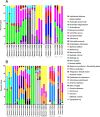Dual-locus DNA metabarcoding reveals southern hairy-nosed wombats (Lasiorhinus latifrons Owen) have a summer diet dominated by toxic invasive plants
- PMID: 32142513
- PMCID: PMC7059939
- DOI: 10.1371/journal.pone.0229390
Dual-locus DNA metabarcoding reveals southern hairy-nosed wombats (Lasiorhinus latifrons Owen) have a summer diet dominated by toxic invasive plants
Abstract
Habitat degradation and summer droughts severely restrict feeding options for the endangered southern hairy-nosed wombat (SHNW; Lasiorhinus latifrons). We reconstructed SHNW summer diets by DNA metabarcoding from feces. We initially validated rbcL and ndhJ diet reconstructions using autopsied and captive animals. Subsequent diet reconstructions of wild wombats broadly reflected vegetative ground cover, implying local rather than long-range foraging. Diets were all dominated by alien invasives. Chemical analysis of alien food revealed Carrichtera annua contains high levels of glucosinolates. Clinical examination (7 animals) and autopsy (12 animals) revealed that the most degraded site also contained most individuals showing signs of glucosinolate poisoning. We infer that dietary poisoning through the ingestion of alien invasives may have contributed to the recent population crashes in the region. In floristically diverse sites, individuals appear to be able to manage glucosinolate intake by avoidance or episodic feeding but this strategy is less tractable in the most degraded sites. We conclude that recovery of the most affected populations may require effective Carrichtera management and interim supplementary feeding. More generally, we argue that protection against population decline by poisoning in territorial herbivores requires knowledge of their diet and of those food plants containing toxic principles.
Conflict of interest statement
The authors have declared that no competing interests exist.
Figures






References
-
- Swinbourne MJ, Taggart DA, Peacock D, Ostendorf B. 2017. Historical changes in the distribution of hairy-nosed wombats (Lasiorhinus spp.): a review. Aust. Mammal. 39(1), 1–16. 10.1071/AM15046) - DOI
-
- Swinbourne MJ, Taggart DA, Sparrow E, Hatch M, Ostendorf B. 2016. Ground penetrating radar as a non-invasive tool to better understand the population dynamics of a fossorial species: mapping the warrens of southern hairy-nosed wombats (Lasiorhinus latifrons). Wildlife Res. 42(8), 678–688. 10.1071/WR15068 - DOI
-
- Woinarski JCZ, Burbidge AA. 2016 Lasiorhinus latifrons In IUCN (International Union for the Conservation of Nature), 2016. The IUCN Red list of Threatened Species, Version 2016: Available from: www.iucnredlist.org (accessed May 2019). (0.2305/IUCN.UK.2016-1.RLTS.T40555A21959203.en).
-
- Taggart DA, Robinson T. 2008 Lasiorhinus latifrons In IUCN (International Union for the Conservation of Nature) 2011, The IUCN Red List of Threatened Species, Version 2011–2. Available from: www.iucnredlist.org (accessed May 2019).
Publication types
MeSH terms
Grants and funding
LinkOut - more resources
Full Text Sources

